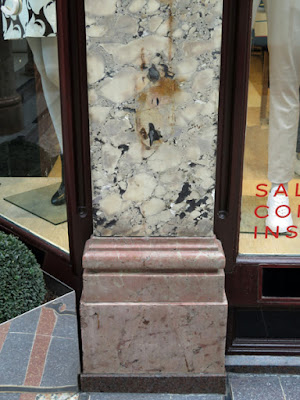 |
| Marble columns and pilasters in County Arcade |
During my preparation of a field trip to Leeds with the Sheffield U3A Geology Group, to explore its building stones, I encountered numerous interesting historic buildings over a series of visits to the city and Leeds Central Library and Leeds Minster – at opposite ends of the city centre – deserved particular mention, when I first encountered them in 2018.
On my last day out to Leeds, towards the end of January 2019, I had worked out the route that I would take with the group the following month, but I had a few nagging doubts about the various decorative stones that I had encountered. In particular, the marble used for the columns in the County Arcade, has been described as Italian Sienna marble in at least one of the documents that I had read during my internet research.
Having specialist interests in identifying building stone, partly based on my practical experience of the building restoration industry in London, I have previously devised the Triton Stone Library – designed to satisfy an architect’s specification to “match the existing” - but I have never pretended to be an expert in decorative stone.
Following an enquiry on Facebook about the identification of the various decorative stones – based on photographs of one of the very many mediaeval churches that I have posted there – I ordered a copy of Decorative Stone - The Complete Sourcebook by Monica Price. As the curator of the Corsi Collection of Decorative Stones at the Oxford University Museum of Natural History, I had been aware of her for many years and thought that this would be a good place to start.
When I received the book in the post, I compared the entries with several photographs that I had previously taken of the columns in County Arcade, as well as those available on the online Corsi catalogue, but I was still none the wiser – as were Francis G. Dimes and Murray Mitchell when they described the marble in The Building Stone Heritage of Leeds as "presumably Italian".
Although a good introduction to the subject, its photographs of the relatively small samples in the Corsi collection, and others held in the museum, aren’t representative of the wide variety in colours and textures that are very often found in ‘marbles'; however, this is shared in common with very many stone trade publications, online portals and company websites that I have seen.
In my experience, I think that there is no substitute for seeing large quantities of any given stone - whatever its type - in the quarry or where used in buildings as large slabs or extensive expanses of masonry, where one can then get a better appreciation of any variation in colour and texture.
 |
| A detail of a marble column in County Arcade |
In my experience, I think that there is no substitute for seeing large quantities of any given stone - whatever its type - in the quarry or where used in buildings as large slabs or extensive expanses of masonry, where one can then get a better appreciation of any variation in colour and texture.
For my planned field trip, I had already done enough but, to satisfy my own curiosity and making the most of a sunny and warm early Monday afternoon in February, I took the train to Leeds again – with the objective to sample the lunchtime menu at Khao Gaeng Thai, before having a close look at the various stones that I had already noted in the arcades that make up the Victorian Quarter.
Firstly noting two varieties of larvikite, with its very distinctive Schiller texture, which has been used extensively for pilasters on the exterior of the three original blocks designed by Frank Matcham – to complement the butterscotch coloured Burmantofts faience – I had a further look at the Tranas Red granite from Sweden that is used as a skirting.
Looking much more closely at the marble columns that mark out the shop fronts along County Arcade, its extremes of colour and texture made me think that this could possibly be Breccia di Seravezza, a notoriously variable marble from the Apuan Alps.
After locating a fossil ammonite in one of the Rosso Verona plinths, I finished off my survey of the building stones of the Victoria Quarter by taking a few quick snaps of the various granites that have been used in the redevelopment of the former Queen Victoria Street.
Grey Hantergantick granite from Bodmin Moor in Cornwall has been originally used here for the flooring, together with pink Peterhead granite used for edgings; however, in places there is another variety of grey granite, which is different and is presumably a later replacement.
 |
| An attempt to identify the marble used in County Arcade |
After locating a fossil ammonite in one of the Rosso Verona plinths, I finished off my survey of the building stones of the Victoria Quarter by taking a few quick snaps of the various granites that have been used in the redevelopment of the former Queen Victoria Street.
 |
| An ammonite fossil in a plinth made of Rosso Verona marble |
Grey Hantergantick granite from Bodmin Moor in Cornwall has been originally used here for the flooring, together with pink Peterhead granite used for edgings; however, in places there is another variety of grey granite, which is different and is presumably a later replacement.









No comments:
Post a Comment